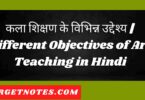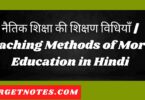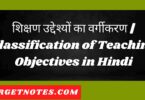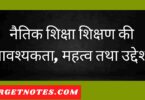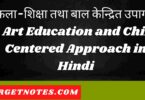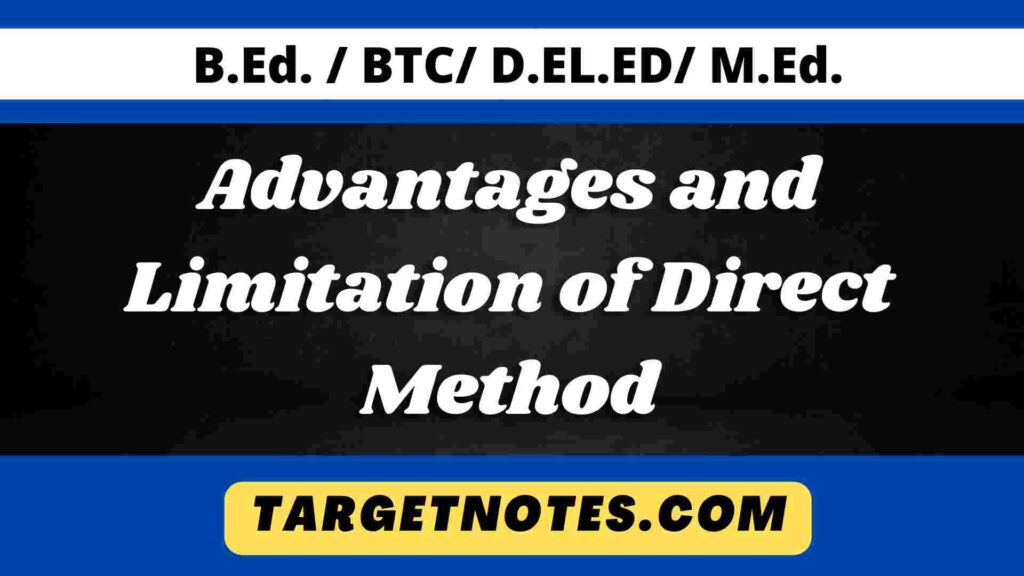
Contents
Advantages of the Direct Method
1. It begets fluency of speech. It also results in easy writing. Direct association between word and meaning tends to improve expression in speech and expression in writing. Macnee believes that the Direct Method is the quickest way of learning and expanding vocabulary. According to him, you can lay a sound foundation of 500 common words.
2. The understanding of English becomes easier. The inhibition of the mother-tongue tends to create a direct bond between idea and expression. “The pupil’s mind goes straight from meaning (object, idea, experience, situation) to the English word and from the English word to its meaning, he understands directly what he hears and reads.” The real progress is made when we think in a language, i.e., when we directly associate the English word and its meaning in our mind.
3. The reading of English becomes easy and pleasant. It lays emphasis on the spoken medium. Its technique requires alertness and activity on the part of both the teacher and the taught. The use of objects, pictures and models, other illustrations, actions, demonstrations etc., makes the lesson interesting and real. This method also, facilitates the study of literature. It imparts a feeling for language. It aims at the practical command of English at the lower stage, but at the higher-stage it aims to develop a critical study. It is the practical command of the language which paves the way for its critical study..
4. It bridges the gap between the active and the passive knowledge.
5. The method is psychologically sound. It follows the main principles of education, viz., “Proceed from particular to general, proceed from concrete to the abstract and practice must precede theory.” Also, the unit of teaching is not a word but a sentence – not the part but the whole.
To sum up, “the application of the principles of the Direct Method means a complete reconstruction of the principles of the traditional conception of language study; it means that in English, as well as in the mother-tongue, the power to use language is not the ‘outcome’ but the condition of all fruitful observation and classification of its phenomenon- We should concentrate on training our pupils to understand and know the grammar of English; rather we should aim at giving pupils the command of language “as a means of expression.” The keynote, the guiding principle, of the English course must be self-expression with all the forms of training that implies- composition in its widest sense, both oral and written.”
Limitation of Direct Method
1. The Direct method aims at the active command of a language. This makes its learning more difficult. Dr. Bretton rightly concludes that “only the clever child can profit by the method.”
2. The fundamental principle of this Method is that the aural-oral appeal is stronger than the visual in fixing foreign phraseology and this is considered to be psychologically sound. Huse objects to it. He is of opinion that the visual presentation is more effective than purely auditory or vocal. All children are not linguistic-minded. Such children cannot be benefited by the Direct method.
3. This method aims to promote the oral aspect of language learning. It “undermines the significance of written work and reading.” “The tendency is to give insufficient attention to reading and not to teach written work systematically.”
Thompson and Wyatt quote O’ Grady to support this view, “There is not enough writing, not enough progress in the type of writing, there is not enough reading.”
4. It can be clearly seen that only a limited number of words can be directly associated with their meanings or objects they re-present. “This material association can be well practised.” But what of those words, phrases and idioms, that bear abstract sense; e.g., ‘Honesty’ ‘Truth’, Integrity’, ‘Beautiful’, ‘Shiver’, ‘Tremble’, ‘Faint’, etc. The meaning of a word like organisation’ cannot be conveyed without defining it through the mother-tongue. The teacher will have to take resort to ‘synonyms’, ‘definitions’ and ‘explanations. There are words in English the definition or explanation of which is difficult and length than the original word. The word ‘mist’ which means “condensed drops of vapour hanging in air” is an explicit example. Besides, there are words which convey more than one meaning. It will prove a lengthy process and an intricate one if all the meanings of such words are aimed at one time. The difference in the meanings of ‘tremble’ and ‘shiver’, ‘small’ and ‘short’, ‘fat’ and ‘thick’, ‘pretty’ and ‘beautiful’, ‘fetch’ and ‘bring’ will not be easily learnt this method.
5. The success of the Direct method requires a proper atmosphere. Champion says, “The easiest and the best way of learning a foreign language is to go to the foreign country, where he will live in the atmosphere of the foreign speech and where the atmosphere of his mother-tongue will be entirely absent; in other words, where the atmosphere of the foreign language will ‘inhibit’ the tendency to think in and use the mother-tongue.” It, however, does not mean that all pupils, desirous of learning English as a second language, should actually go to England and adopt English manners and customs in order to learn English. If, however, he means so, it is surely a ludicrous idea. Champion’s intention is clear by the last clause where the atmosphere of the foreign language will ‘inhibit’ the tendency to think in and use the mother-tongue. I have already said that this method requires an atmosphere. Champion perhaps wants that English should enjoy its old honour and pride and that it should dominate the curriculum-that English should continue to be the medium of instruction in the teaching of all the subjects. It is not the demand of our day. We cannot put back the clock. In our day, we aim at the harmonious development of our youngmen. There are many other subjects for a pupil to learn. The teaching of these subjects has to be done through the medium of the mother-tongue.
As is the general practice in our schools, either of the first three or more periods is allotted to the teaching of English. If suppose, it is the first period, the second is that of the mother-tongue, Mathematics or History or Geography or Civics. The medium of instruction of these subjects is the mother-tongue. Therefore, the English atmosphere created by the teacher in his perod will soon disappear and lose its significance and total effect. The pupils will find themselves transported from England to India with the ringing of the bell. This may appear to be supporting the view of Champion but I mean that it is not ‘practically possible in Indian schools and colleges to maintain throughout the whole day the atmosphere of English. West says that the greater number of Indians require only a ‘passive knowledge of English’ and we should devise such methods which could help us to achieve this target.
6. We lack in skilled teachers who can teach effectively by applying this method in their class-room. Normally, a teacher in Indian schools is not exclusively ‘English teacher’, even though he may be appointed as such. He is an ‘assistant’ teacher and has to teach two subjects or more, in addition to English. His work-load amounts to at least 36 periods in a working week of 48 periods. The plight of Junior teachers is more deplorable as they have at their 48 periods allotted for teaching different subjects. Besides teaching, teachers have to do clerical work of collecting fees, keeping accounts and maintaining attendance registers. It is only a week schedule for the teaching of English in a class. Hence, the attention and concentration and the energy of the teacher is shared by the other subjects. It is difficult for him to practise with such time consuming methods.
7. I have mentioned above that grammar is to be taught inductively in connection with reading and composition lessons. This means that there should be such readers wherein the reading material and grammar are closely-related. But there is practically no supply of such readers. Therefore, this is the inapplicability of this method.
8. This method in all its rigour mistakes the end for the means, the goal for the path, that leads to it-the direct association of word and phrases with their meanings is the eventual objective of language study and not a means. According to Thompson & Wyatt, “We cannot expect the pupil to make the association at the outset.” This means that the meaning of the new phraseology of a foreign language tends the pupil to think and utter in his own mind the / equivalent word of his vernacular, e.g., I desire to convey the meaning of the word ‘sit’. According to this method process, I will say, ‘I sit’ and demonstrate it by sitting in the chair or on the table. “The act of sitting will, no doubt, fix up in their mind the spoken sound.” I sit’ but the demonstration, the act of sitting, which is to ingrain in their mind the meaning of ‘I sit’, finds its expression in their minds ‘I sit’, in their mother-tongue, i.e, “main baithta hun”
The Direct Method which enjoys the privilege of being psychologically sound, ignores this fact about human nature.
9. Our class-rooms are overcrowded. Most of the schools have no buildings of their own. Class-rooms fall short of accommodation and children cannot sit properly as the seats provided for them are neither sufficient in quantity, nor efficient in quality. The Direct Method requires ample space for the free and independent activities of both the teacher and the taught. Its application also needs a few pupils in the class so that each pupil is closely observed. The situation is just the reverse. Therefore, there is practical difficulty in practising this method.
10. It is a difficult and expensive method. Our schools cannot provide for sufficient equipment and facilities for using this method successfully.
11. I have just mentioned about the paucity of the English teachers skilled in this method. I have also mentioned that it is an expensive method. In Indian Schools and Colleges, English teachers have to teach other subjects also along with English.
Let us suppose for a while the dilemma in which a professional teacher usually finds himself. He is appointed in accordance with his academic qualifications and experience. It often happens that he is given other subjects also to teach. e.g., an M.A. in English is qualified to teach English to Intermediate classes. Suppose he had offered Hindi and Economics at his graduate level. He will, in this case, be given Hindi and Economics to teach high school classes also. Besides teaching work, teachers in Intermediate Colleges have to do fee collection and register work-a work which is of purely clerical nature. Some of them are to look after various activities of unacademic nature. Work of such diverse nature fritters away his energies and teachers are found unable to do justice to their teaching work.
These and the like multifarious occupations of English teachers do not leave sufficient time and provide them with enough opportunities to put in their best efforts and consequently, they remain over burdened with work.
Conclusion-The limitations of the this method, however, are many, yet the method can be practised at least at the lower and at the middle stages, where less explanatory device in teaching is required. This should be practised to achieve better result, to prepare a sound background of the oral work at the earlier stage and to minimise his future difficulties. If attempted at in the right manner and in the right spirit, it works and its results are highly satisfaction. It offers more opportunities for speech which is essential for laying á firm basis for acquiring linguistic habits.
“Direct association”, says Prof. V. K. Gokak, “between the word and the thing meant gives better results than translation. Direct association of this kind can be promoted by means of activity appropriate to what the pupil is learning by setting-up situations which stimulate those of real life.”
IMPORTANT LINK
- The Natural of Direct Method of English Teaching
- Advantages and Limitation of Direct Method
- New method of English teaching
- Methods of English Teaching | The Translation-cum-Grammar Method | Merits and Demerits of the Method
- General and Particular aims and objectives of English teaching

